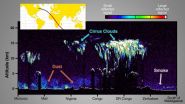(Press-News.org) From Saharan dust storms to icy clouds to smoke on the opposite side of the continent, the first image from NASA's newest cloud- and aerosol-measuring instrument provides a profile of the atmosphere above Africa.
The Cloud-Aerosol Transport System instrument (CATS), was launched Jan. 10 aboard a SpaceX Dragon spacecraft, and was installed on the International Space Station on Jan. 22. From its berth on the station, CATS sends laser pulses toward Earth, detecting the photons that bounce off of particles in the atmosphere to measure clouds, volcanic ash, pollutants, dust and other aerosols.
"Everything's turned on and we're getting data, both daytime and nighttime," said Matt McGill, principal investigator of CATS from NASA's Goddard Space Flight Center in Greenbelt, Maryland. "We can see the ground, stratus clouds, cirrus clouds and over Africa we can see desert dust. The photon-counting detection approach used in CATS appears to be more sensitive than previous lidar [light detection and ranging] sensors."
The CATS image shows a profile of particles in the atmosphere over a swath of Africa, from 30 degrees North to 30 degrees South, as the space station flew over it in the early morning of Feb. 11.
Over northern Africa, particles - likely dust kicked up by Saharan windstorms - reach heights of 2.5 to 3 miles (4 to 5 kilometers), said John Yorks, science lead for CATS at Goddard. As the space station approached the equator, the instrument picked up higher atmospheric particles - thin, wispy ice clouds as high as 10 miles above the surface (16 km). South of the cloudy tropics, aerosols appeared closer to the ground, likely smoke from biomass burning. The results from CATS can also be combined with images of Earth from instruments like the Moderate Resolution Imaging Spectroradiometer, flown on the Terra and Aqua satellites.
The CATS team is calibrating data from the two wavelengths on the primary laser operating now - 532 nanometers and 1064 nanometers. The backup laser on CATS has three wavelengths. The different wavelengths reflect differently when they hit aerosols, so comparing the returns from multiple wavelengths allows the scientists to distinguish dust from ice, smoke or other airborne particles.
"The differences between wavelengths are subtle, but the ratio of the intensity of the reflection at different wavelengths indicate aerosol type," Yorks said. The CATS team will also look at other characteristics of the laser pulse returns to help with particle identification.
Before receiving data plots like the one over Africa, the team aligned the telescope pointing. They used motors to adjust optics inside the instrument during nighttime segments until they got the strongest signal, indicating that the telescope's field of view aligned with the reflected laser photons.
"It's a difficult process, and it took us several days to get the telescope aligned," Yorks said. "But once we did, we were able to see these really small features, such as the thin cirrus clouds and the thin aerosol layers."
Data from CATS will help scientists model the structure of dust plumes and other atmospheric features, which can travel far distances and impact air quality. Climate scientists will also use the CATS data, along with data from other Earth-observing instruments, to look at trends and interactions in clouds and aerosols over time.
CATS is not only a science instrument, but a demonstration of how researchers can use the space station as a base for Earth-observing studies.
"The ISS is an interesting, low-cost platform for demonstrating new Earth Science measurements and technologies," McGill said. "For example, the ability to downlink data, continuously, in near-real time is a great advantage for testing flow of data into predictive models. However, practical limitations come with the ISS platform. For example, interruptions to operations occur due to visiting vehicle arrivals and departures. If your science demands 100 percent operational duty cycle, then ISS may not be the platform of choice."
The CATS team is moving forward with calibration and improving computer programs to identify types of aerosols, and by April hopes to be able to provide a data product to aerosol monitoring groups three hours after the data are collected, and provide products to the public within 12 hours.
CATS was designed and built by a small team at Goddard, with funds from the International Space Station Program's NASA Research Office, which also provided a spot on the station. Funding for the processing of data comes from NASA's Earth Science Division. The instrument is designed to operate for at least six months, with a goal of three years.
INFORMATION:
For more information on CATS, visit:
http://cats.gsfc.nasa.gov/
For more information on the International Space Station, visit:
http://www.nasa.gov/mission_pages/station/main/index.html
If you walk into your local drug store and ask for a supplement to help you sleep, you might be directed to a bottle labeled "melatonin." The hormone supplement's use as a sleep aid is supported by anecdotal evidence and even some reputable research studies. However, our bodies also make melatonin naturally, and until a recent Caltech study using zebrafish, no one knew how--or even if--this melatonin contributed to our natural sleep. The new work suggests that even in the absence of a supplement, naturally occurring melatonin may help us fall and stay asleep.
The study ...
(Boston)--Racial and ethnic disparities in the receipt of health care (typically referring to minorities not receiving needed care) are well known. A recent review in the journal Milbank Memorial Quarterly has now found that while race/ethnicity is not consistently associated with the overuse of medical care (unnecessary care that does not improve patient outcomes). However, when overuse occurs, a substantial proportion occurs among white patients. These findings may lead to a better understanding of how and why race/ethnicity might be associated with overuse and may result ...
(WASHINGTON, March, 6, 2015) - A report, released today from the American Society of Hematology (ASH) in its journal, Blood, presents an innovative, sustainable new role for hematologists, particularly those specializing in non-malignant blood diseases, for today's rapidly changing U.S. health-care system. The report, published online as a Blood Forum article, outlines several models for a "systems-based clinical hematologist," a centralized position within hospitals and health-care systems specializing in non-malignant blood disorders.
In the report, "The Role of Hematologists ...
Researchers have identified more than 100 areas within U.S. waters that should be considered biologically important when making management and regulatory decisions about human activities that could affect whales, dolphins and porpoises.
The creation of Biologically Important Areas (BIAs) are described in a special issue of the journal Aquatic Mammals. Expert judgment was combined with published and unpublished data to identify 131 BIAs covering 24 species, stocks or populations in seven regions of the U.S. It is the first time so much information has been brought together ...
Having a high sense of purpose in life may lower your risk of heart disease and stroke, according to a new study led by researchers at Mount Sinai St. Luke's and Mount Sinai Roosevelt and presented on March 6 at the American Heart Association's EPI/Lifestyle 2015 Scientific Sessions in Baltimore.
The new analysis defined purpose in life as a sense of meaning and direction, and a feeling that life is worth living. Previous research has linked purpose to psychological health and well-being, but the new Mount Sinai analysis found that a high sense of purpose is associated ...
Using a mouse model of rheumatoid arthritis, scientists have discovered that a form of cellular immunotherapy by intravenous administration of monocytic myeloid-derived suppressor cells, or M-MDSCs, might be an effective treatment for the disease in humans. In a report published in the March 2015 issue of the Journal of Leukocyte Biology, researchers show that M-MDSCs are capable of inhibiting T cell proliferation, as well as B cell proliferation and antibody production. As a result, the arthritic mice experienced improvements in their symptoms.
"I hope this study will ...
Tropical Cyclone 15S continued to meander in the Mozambique Channel of the Indian Ocean when NASA's Aqua satellite passed overhead and captured a picture of it. The storm's lack of direction is short-lived, however, as forecasters at the Joint Typhoon Warning Center or JTWC expect that the storm will move in a southwesterly direction and landfall in west central Madagascar by March 9.
The Moderate Resolution Imaging Spectroradiometer or MODIS instrument that flies aboard NASA's Aqua satellite captured a visible image of Tropical Cyclone 15S on March 5 at 11:25 UTC (6:25 ...
San Diego, CA--Among prescriptions filled for menopausal hormone therapy (HT) in the U.S., almost half now are custom-compounded "bioidentical" hormones, according to analysis of a recent survey of nearly 500 pharmacists. The study results will be presented Friday March 6th at the Endocrine Society's 97th annual meeting in San Diego.
Custom-compounded prescriptions, which are mixed for an individual according to a doctor's prescription, are not well-regulated or monitored by the U.S. Food and Drug Administration (FDA).
"Despite the increased quality risks and the lack ...
San Diego, CA--Men with borderline testosterone levels have higher rates of depression and depressive symptoms than the general population, new research finds. The results will be presented Saturday, March 7, at ENDO 2015, the annual meeting of the Endocrine Society in San Diego.
"Over half of men referred for borderline testosterone levels have depression. This study found that men seeking management for borderline testosterone have a very high rate of depression, depressive symptoms, obesity and physical inactivity," said principal study author Michael S. Irwig, MD, ...
San Diego, CA--Menopausal hormone therapy (HT) does not have a significant effect on death, according to a new review of the medical literature published over the past three decades. The results, which included studies with follow-up as long as 18 years, will be presented Friday at the Endocrine Society's 97th annual meeting in San Diego.
"At present, we do not have evidence that hormone therapy in postmenopausal women increases mortality or protects from death compared with women who never used hormones," said lead investigator Khalid Benkhadra, MD, a research fellow ...


